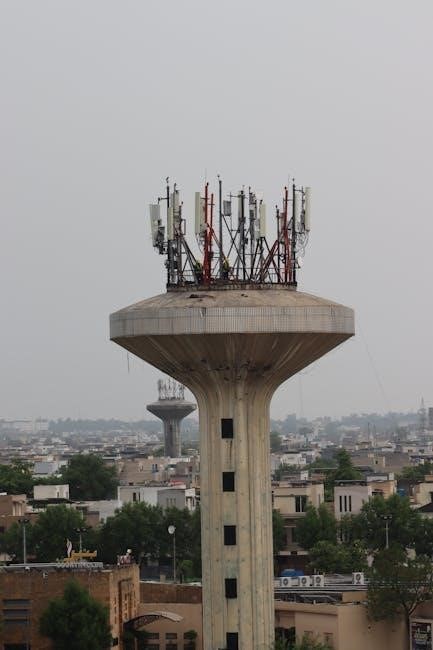Bradford White Water Heater Instruction Manual: A Comprehensive Guide
Bradford White offers diverse heating solutions – gas, electric, tankless, and heat pump models․ This manual details installation, operation, maintenance, and troubleshooting for optimal performance․
Understanding Your Bradford White Water Heater Model
Bradford White manufactures a wide array of water heaters, including atmospheric gas, upright electric, Infiniti® tankless gas, and AeroTherm® heat pump models․ Identifying your specific model is crucial for correct operation and maintenance․
Locate the model and serial number on the heater’s rating plate, typically found on the exterior․ This information is vital when ordering replacement parts or contacting customer support․ Different series – like the Infiniti or AeroTherm – have unique features and require specific procedures․ Understanding these distinctions ensures efficient and safe operation of your Bradford White unit․
Safety Precautions & Warnings

WARNING: Improper installation, operation, or maintenance can cause serious injury, death, or property damage․ Always disconnect power (electric) or gas supply before servicing․
Never attempt repairs beyond your capabilities; contact a qualified technician․ Bradford White water heaters can produce scalding water – set the thermostat to a safe temperature (120°F is recommended)․ Ensure proper ventilation for gas models to prevent carbon monoxide poisoning․ Regularly test the pressure relief valve․ Failure to follow these precautions voids the warranty and poses significant risks․

Initial Setup and Installation
IMPORTANT: Installation must comply with local codes and regulations․ Before starting, inspect the unit for shipping damage․ Ensure the water heater is placed on a level, stable surface capable of supporting its weight when full․
Proper piping connections are crucial – use dielectric unions to prevent corrosion․ Bradford White recommends professional installation for gas models, including proper gas line connection and leak testing․ Verify correct voltage for electric units․ Flush the tank to remove debris before connecting to the water supply․

Checking for Proper Ventilation
Crucially, gas water heaters require adequate ventilation to safely exhaust combustion gases․ Bradford White mandates following all local and national codes regarding venting․ Inspect the vent pipe for obstructions, proper slope, and secure connections․
Ensure sufficient fresh air intake is available, especially in confined spaces․ Improper ventilation can lead to carbon monoxide buildup – a life-threatening hazard․ Never obstruct air intake or exhaust vents․ Regularly inspect the venting system for corrosion or damage, and address any issues immediately․
Water Supply Connection
Before connecting, flush the water lines to remove debris․ Bradford White recommends using dielectric unions to prevent corrosion when connecting copper to the water heater’s nipples․ Ensure all connections are tight, using pipe dope or Teflon tape approved for potable water systems․
Install a full-flow shut-off valve on the cold water inlet․ Check for leaks immediately after connection and pressurization․ Grounding the water heater is essential for safety; follow local electrical codes․ Verify water pressure is within the heater’s specified range before operation․

Operating Instructions
Bradford White water heaters are designed for reliable, efficient operation․ Allow sufficient time for the tank to fill completely before initial use․ Avoid rapid temperature adjustments, as this can stress the system․ Regularly check the temperature and pressure relief valve for proper function․
For optimal performance, avoid excessive hot water usage during peak demand times․ Familiarize yourself with the specific controls for your model – digital displays offer precise temperature settings․ Always follow safety precautions and consult the troubleshooting section for any issues․

Thermostat Adjustment & Temperature Settings
Bradford White heaters feature adjustable thermostats for customized comfort․ Locate the thermostat dial, typically behind an access panel․ Rotate clockwise to increase, and counterclockwise to decrease the water temperature․ Caution: Never exceed 140°F (60°C) to prevent scalding․
Digital models offer precise temperature control via the control panel․ Refer to the panel’s instructions for setting desired temperatures․ Regularly check the set temperature to ensure consistent hot water supply․ Adjust seasonally to optimize energy efficiency and user comfort․
Understanding the Control Panel (Digital Models)
Bradford White digital models boast intuitive control panels․ The display shows current water temperature, set temperature, and operational status․ Use the “Up” and “Down” arrows to adjust the desired temperature․ The “Mode” button cycles through operating modes – typically “Vacation,” “Comfort,” and “Energy Saver․”
Error codes indicate potential issues; consult the troubleshooting section of this manual for explanations; Some models feature diagnostic tests accessible through the control panel․ Familiarize yourself with the panel’s functions for efficient operation and maintenance․
Maintenance & Troubleshooting
Bradford White water heaters require periodic maintenance for longevity․ Sediment flush annually to maintain efficiency and prevent damage․ Inspect the anode rod every three years, replacing it when depleted to protect the tank․ Regularly test the pressure relief valve to ensure proper operation․
Troubleshooting common issues like lack of hot water or leaks is crucial․ Refer to the detailed sections within this manual for step-by-step guidance․ Always prioritize safety and disconnect power/gas before attempting any repairs․ Contact a qualified technician for complex problems․
Sediment Flush Procedure
Sediment accumulates in the tank, reducing efficiency․ To flush, turn off power/gas and cold water supply․ Attach a hose to the drain valve at the tank’s base․ Open the valve, allowing sediment to drain into a bucket․
Periodically open and close the valve to dislodge stubborn buildup․ Once the water runs clear, close the drain valve and slowly refill the tank․ Bradford White recommends annual flushing․ Be cautious of hot water during this process․ This simple maintenance extends the heater’s lifespan and optimizes performance․
Anode Rod Inspection & Replacement
The anode rod protects the tank from corrosion․ Inspect it every three years, or sooner in areas with corrosive water․ Turn off power/gas and water supply․ Locate the anode rod (usually under a hex head plug on top of the tank)․
Carefully remove the rod – it may be difficult if heavily corroded․ If significantly depleted (less than 6 inches of core wire remaining), replace it with a new Bradford White anode rod․ Proper anode rod maintenance is crucial for extending the water heater’s lifespan and preventing leaks․
Pressure Relief Valve Testing
Bradford White recommends testing the pressure relief valve (PRV) annually to ensure proper operation․ Locate the PRV, typically on the top or side of the water heater․ Place a bucket under the discharge pipe and carefully lift the test lever․
Water should discharge forcefully․ If no water flows, or if it drips constantly afterward, the PRV is faulty and must be replaced by a qualified plumber․ Never attempt to plug or block the discharge pipe․ A functioning PRV prevents dangerous pressure buildup within the tank․
Common Issues & Solutions

Bradford White water heaters, while reliable, can experience issues․ No hot water often indicates a tripped circuit breaker (electric) or a pilot light outage (gas)․ Leaking may stem from loose connections, a faulty PRV, or tank corrosion – inspect carefully․
Strange noises like popping or rumbling suggest sediment buildup; a flush is needed․ If problems persist, consult a qualified plumber․ Do not attempt repairs beyond your expertise․ Always disconnect power/gas before inspection․
No Hot Water – Potential Causes
Several factors can cause a Bradford White water heater to fail to produce hot water․ For electric models, check the circuit breaker – a tripped breaker is a common culprit․ For gas units, verify the pilot light is lit; relighting instructions are in the manual․ A faulty thermostat, heating element (electric), or gas valve can also be responsible․
Insufficient gas supply or a blocked flue (gas) may also contribute․ Always prioritize safety – if unsure, contact a qualified technician․
Leaking Water Heater – Identifying the Source
A leaking Bradford White water heater demands immediate attention․ Check connections first – inlet/outlet pipes, the temperature and pressure relief (T&P) valve, and drain valve․ A leak from the tank itself often indicates internal corrosion and requires replacement․ Inspect the T&P valve; a constant drip suggests it’s failing and needs replacement by a professional․
Small leaks around fittings can often be tightened, but tank leaks are serious․ Safety first: shut off the water supply and power before investigating!
Strange Noises – Diagnosis & Repair
Unusual sounds from your Bradford White water heater can signal problems․ Rumbling often indicates sediment buildup at the tank’s bottom; a flush is needed․ Popping noises may stem from overheating – check the thermostat․ Whistling sounds could point to a restriction in the water supply line or a faulty inlet valve․
If you hear hissing, immediately shut off the gas or electricity and call a qualified technician․ Ignoring noises can lead to more significant, costly repairs or even a dangerous situation․
Warranty Information & Registration
Bradford White water heaters are backed by industry-leading warranties, varying by model․ Typically, tank warranties range from 6 to 10 years, while parts warranties cover one year․ Registering your water heater promptly after installation is crucial to activate the full warranty coverage․
Registration can be completed online through the Bradford White website․ Keep your proof of purchase and model/serial numbers readily available․ Failure to register may limit your warranty benefits․ Detailed warranty terms are included in the product documentation․
Specific Model Series Instructions
Bradford White offers specialized instructions for distinct product lines․ The Infiniti tankless series requires specific venting and gas line considerations, detailed in its dedicated guide․ AeroTherm heat pump models necessitate understanding of electrical requirements and defrost cycles, outlined separately․
Consult the specific manual accompanying your model for detailed guidance․ These guides cover unique features, control settings, and troubleshooting steps tailored to each series․ Ignoring these specific instructions may void the warranty or impact performance․ Always prioritize the model-specific documentation․
Infiniti Tankless Water Heater Guide
Bradford White’s Infiniti tankless heaters deliver on-demand hot water․ Proper venting is crucial – follow local codes for stainless steel or PVC․ Gas models require adequate gas supply pressure; electric models, sufficient amperage․ Initial startup involves flushing the unit to remove debris․
Temperature settings are adjusted digitally․ Understand the flow rate requirements for optimal performance․ Regular descaling, using a compatible solution, prevents mineral buildup․ Refer to the full manual for detailed error code explanations and troubleshooting steps․ Infiniti models offer advanced features – explore them!
AeroTherm Heat Pump Water Heater Guide
Bradford White’s AeroTherm utilizes heat pump technology for energy-efficient water heating․ Installation requires ample airflow – minimum clearances are vital for performance․ Ensure the unit is level and positioned in a space maintaining 40-90°F․ Initial startup may take longer than traditional heaters․
Understand the operating modes: Heat Pump Only, Hybrid, and Electric․ Regularly clean the air filter for optimal efficiency․ Monitor the condensate drain line to prevent clogs․ The digital display provides performance data and error codes․ Refer to the manual for specific troubleshooting guidance and warranty details․
Parts Diagrams & Replacement
Bradford White provides detailed parts diagrams for all models, accessible through their website or by contacting customer support․ Replacement parts should always be genuine Bradford White components to maintain safety and warranty validity․ Common replacement items include heating elements, thermostats, and the pressure relief valve․
Before any repair, disconnect power (electric) or gas supply․ Carefully document the existing configuration before disassembly; Improper installation can lead to leaks or malfunctions․ Refer to the specific model’s diagram for correct part numbers and assembly instructions․ Always test the unit after replacing any component․
Gas Water Heater Specifics
Bradford White gas water heaters require proper ventilation to prevent carbon monoxide buildup․ Pilot light relighting instructions are clearly labeled on the unit and in this manual – follow them precisely․ The gas valve controls fuel flow and features safety shut-off mechanisms; never attempt to modify it․
Regularly inspect the burner for obstructions and ensure proper flame color (blue)․ A yellow or orange flame indicates incomplete combustion․ If you smell gas, immediately evacuate and contact your gas company․ Qualified technicians should perform all gas line connections and repairs․

Pilot Light Relighting Instructions
Before relighting the pilot, turn the gas control valve to the “OFF” position and wait at least five minutes to allow any accumulated gas to dissipate․ Locate the pilot assembly, typically behind an access panel․ Turn the gas control knob to “PILOT” and depress it firmly․ Simultaneously, press the red igniter button repeatedly until the pilot flame ignites․
Continue holding the gas control knob down for 30 seconds after ignition․ If the pilot doesn’t stay lit, repeat the process․ If it fails after several attempts, consult a qualified technician․ Never attempt to relight if you smell gas․
Gas Valve Operation & Safety

The gas control valve regulates gas flow to the burner and pilot․ It features settings for “OFF,” “PILOT,” and “ON․” Always ensure the area around the water heater is clear and well-ventilated․ Never attempt to adjust or repair the gas valve yourself; this requires a qualified technician․
If you smell gas, immediately evacuate the area, and contact your gas company or fire department․ Do not operate any electrical switches, as this could ignite the gas․ Regular inspection by a professional is crucial for safe operation․ Tampering with the valve is dangerous․
Electric Water Heater Specifics
Bradford White electric water heaters utilize resistance heating elements to warm water․ Proper electrical supply is paramount for safe and efficient operation․ These units require dedicated circuits, sized according to the heater’s wattage, as detailed on the unit’s nameplate․
Incorrect wiring or undersized breakers can lead to overheating and potential fire hazards․ Never use extension cords․ Always disconnect power at the breaker before performing any maintenance․ Ensure the grounding is correct and compliant with local electrical codes․ Professional installation is highly recommended․
Circuit Breaker Requirements
Bradford White electric water heaters necessitate specific circuit breaker sizes, directly correlating to the heater’s wattage․ Typically, smaller models (e․g․, 30-40 gallon) require a single 30-amp breaker, while larger capacities (50+ gallon) often demand dual 30-amp breakers or a single 50-amp breaker․
Always verify the exact amperage requirement listed on the water heater’s data plate․ Using an incorrectly sized breaker poses a significant safety risk, potentially causing overheating, fire, or damage to the appliance․ Consult a qualified electrician for proper installation and breaker sizing․
Element Replacement Guide

Bradford White electric water heater element replacement requires careful procedure․ First, disconnect power at the circuit breaker․ Drain the tank below the element level․ Access the element cover, typically secured with screws, and remove it․ Disconnect the wires connected to the element․
Unscrew the old element using an element wrench․ Apply Teflon tape to the threads of the new element before installation․ Reconnect wires, replace the cover, refill the tank, and restore power․ Caution: Ensure the correct voltage and wattage element is used․
Contacting Bradford White Support
Bradford White provides extensive support resources for its water heaters․ Online, visit their official website for detailed FAQs, downloadable manuals, and troubleshooting guides․ These resources often address common issues and provide step-by-step solutions․ For direct assistance, customer service is available via phone during business hours․
Their knowledgeable representatives can assist with warranty claims, parts inquiries, and technical support․ Website access provides parts diagrams and replacement information․ Prompt and helpful support ensures a positive ownership experience with Bradford White products․
Online Resources & FAQs
Bradford White’s website is a comprehensive hub for support․ You’ll find detailed product manuals, specification sheets, and warranty information readily available for download․ The extensive FAQ section addresses common questions regarding installation, operation, and maintenance․ Interactive online parts diagrams simplify identifying replacement components․
Troubleshooting guides assist in diagnosing and resolving typical issues․ Registration of your water heater is easily done online, streamlining warranty claims․ These digital resources empower owners with self-service solutions and ensure quick access to vital product information․
Customer Service Phone Numbers
For direct assistance, Bradford White provides dedicated customer service lines․ Technical support for installers and contractors is available at 1-800-531-2111․ Homeowners seeking assistance with product questions or warranty claims can reach customer support at 1-877-272-3673․
These lines are staffed by knowledgeable representatives ready to guide you through troubleshooting, parts ordering, and warranty processes․ Please have your model and serial number readily available when calling to expedite assistance․ Bradford White prioritizes responsive support to ensure customer satisfaction․
























































